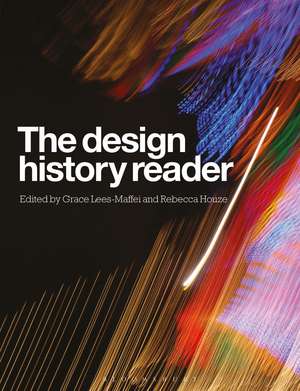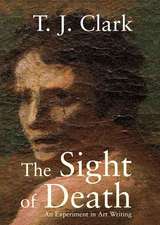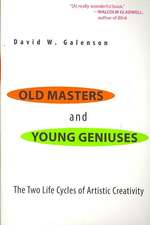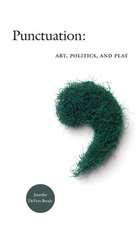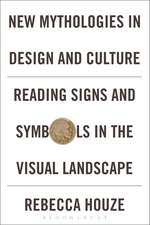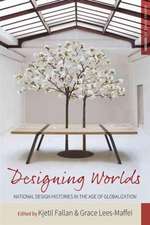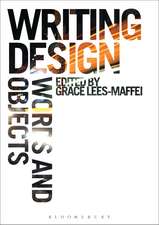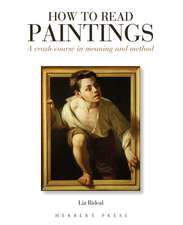The Design History Reader
Editat de Grace Lees-Maffei, Rebecca Houzeen Limba Engleză Paperback – 27 mar 2019
Preț: 232.42 lei
Preț vechi: 282.58 lei
-18% Nou
Puncte Express: 349
Preț estimativ în valută:
44.47€ • 46.43$ • 36.81£
44.47€ • 46.43$ • 36.81£
Carte disponibilă
Livrare economică 14-28 martie
Preluare comenzi: 021 569.72.76
Specificații
ISBN-13: 9781350121034
ISBN-10: 1350121037
Pagini: 560
Ilustrații: 70 bw illus
Dimensiuni: 189 x 246 mm
Greutate: 1.08 kg
Editura: Bloomsbury Publishing
Colecția Bloomsbury Visual Arts
Locul publicării:London, United Kingdom
ISBN-10: 1350121037
Pagini: 560
Ilustrații: 70 bw illus
Dimensiuni: 189 x 246 mm
Greutate: 1.08 kg
Editura: Bloomsbury Publishing
Colecția Bloomsbury Visual Arts
Locul publicării:London, United Kingdom
Caracteristici
Looks beneath-the-surface at some of our most familiar objects, from the microwave to the ipod, from mobile phone design to Nike branding, from Beatles' record sleeves to the Ferrari
Notă biografică
Grace Lees-Maffei is Senior Lecturer in the History and Theory of Design and Applied Arts at the University of Hertfordshire.Rebecca Houze is Associate Professor of Art History at Northern Illinois University.
Cuprins
List of Illustrations Acknowledgements Notes on Contributors General Introduction, Grace Lees-Maffei Part One: Histories Introduction to Part One, Rebecca Houze SECTION 1: NEW DESIGNERS 1676- 1820 Introduction, Grace Lees-Maffei 1. An Indian Basket, Providence, Rhode Island, 1676, Laurel Thatcher Ulrich 2. A Slipware Dish by Samuel Malkin: An Analysis of Vernacular Design, Darron Dean 3. Of The Division of Labour, Adam Smith 4. The Wedgwood Slave Medallion: Values in Eighteenth-Century Design, Mary Guyatt 5. Manufacturing, Consumption and Design in Eighteenth Century England, John Styles Guide to Further Reading for Section 1 SECTION 2: DESIGN REFORM 1820-1910 Introduction, Rebecca Houze 6. Science, Industry, and Art, Gottfried Semper 7. The Nature of Gothic, John Ruskin 8. The Ideal Book, William Morris 9. The 'American System' and Mass-Production from Industrial Design, John Heskett 10. The 1900 Paris Exposition, from Art Nouveau in Fin-de-Siècle France, Debora Silverman 11. The Art and Craft of the Machine, Frank Lloyd Wright Guide to Further Reading for Section 2 SECTION 3: MODERNISMS 1908-1950 Introduction, Rebecca Houze 12. Introduction to Modernism in Design, Paul Greenhalgh 13. Ornament and Crime, Adolf Loos 14. Werkbund Theses and Antitheses, Hermann Muthesius and Henry van de Velde 15. The Modern Movement before Nineteen-fourteen from Pioneers of Modern Design, Nikolaus Pevsner 16. The Coloristes and Charles-Edouard Jeanneret, from Modernism and the Decorative Arts in France, Nancy Troy 17. From Workshop to Laboratory, from The Bauhaus Reassessed, Gillian Naylor 18. The Search for an American Design Aesthetic: from Art Deco to Streamlining, Nicolas Maffei Guide to Further Reading for Section 3 SECTION 4: WAR/POSTWAR/COLD WAR 1943-1970 Introduction, Grace Lees-Maffei 19. Utility Furniture and the Myth of Utility 1943-1948, Matthew Denney 20. 'Here Is the Modern World Itself' the Festival of Britain's Representations of The Future Becky Conekin 21. Populuxe, Thomas Hine 22. The Khrushchev Kitchen: Domesticating the Scientific-Technological Revolution Susan E. Reid 23. All That Glitters is Not Stainless, Reyner Banham Guide to Further Reading for Section 4 SECTION 5: POSTMODERNISMS 1967-2006 Introduction, Rebecca Houze 24. A Significance for A & P Parking Lots, or Learning from Las Vegas, Robert Venturi, Denise Scott-Brown and Steven Izenour 25. The Ecstasy of Communication, Jean Baudrillard 26. There is No Kitsch, There is Only Design!, Gert Selle 27. Deconstruction and Graphic Design: History Meets Theory, Ellen Lupton and J. Abbott Miller 28. What was Philippe Starck thinking of? P. Lloyd and D. Snelders 29. Fabricating Identities: Survival and the Imagination in Jamaican Dancehall Culture, Bibi Bakare-Yusuf Guide to Further Reading for Section 5 SECTION 6: SUSTAINABLE FUTURES 1960-2003 Introduction, Rebecca Houze 30. Operating Manual for Spaceship Earth, R. Buckminster Fuller 31. How to Outmode a $4,000 Vehicle in Two Years, from The Waste Makers, Vance Packard 32. Do-It-Yourself Murder: the Social and Moral Responsibility of the Designer, from Design for the Real World, Victor Papanek 33. Material Doubts and Plastic Fallout, from American Plastic, Jeffrey L. Meikle 34. Introduction, The Green Consumer Supermarket Guide, Joel Makower, John Elkington, and Julia Hailes 35. Redefining Rubbish: Commodity Disposal and Sourcing, Nicky Gregson and Louise Crewe 36. The Hannover Principles. Design for Sustainability, William McDonough Guide to Further Reading for Section 6 Part Two: Methods and Themes Introduction to Part Two , Grace Lees-Maffei SECTION 7: FOUNDATIONS, DEBATES, HISTORIOGRAPHY, 1980-1995Introduction, Grace Lees-Maffei 37. Taking Stock in Design History, Fran Hannah and Tim Putnam 38. The State of Design History, Part I: Mapping the Field, Clive Dilnot 39. Design History and the History of Design, John A. Walker 40. Design History or Design Studies: Subject Matter and Methods, Victor Margolin 41. Resisting Colonization: Design History Has Its Own Identity, Jonathan M. Woodham Guide to Further Reading for Section 7 SECTION 8: OBJECTS, SUBJECTS AND NEGOTIATIONS Introduction, Grace Lees-Maffei 42. Object as Image: The Italian Scooter Cycle, Dick Hebdige 43. The Most Cherished Objects in the Home, Mihaly Csikszentmihalyi and Eugene Rochberg-Halton 44. How the Refrigerator Got Its Hum, Ruth Schwartz Cowan 45. The History of Craft, Paul Greenhalgh 46. Faith, Form and Finish: Shaker Furniture in Context, Jean M. Burks Guide to Further Reading for Section 8 SECTION 9: GENDER AND DESIGN Introduction, Rebecca Houze 47. FORM/female FOLLOWS FUNCTION/male: Feminist Critiques of Design, Judy Attfield 48. The Architect's Wife, Introduction to As Long As Its Pink, Penny Sparke 49. Humanizing Modernism: the Crafts, 'Functioning Decoration,' and the Eamses, Pat Kirkham 50. 'In London's maze': the pleasures of fashionable consumption from The Hidden Consumer, Christopher Breward 51. Self-Made Motormen: The Material Construction of Working-class Masculine Identities through Car Modification, Andrew Bengry-Howell and Christine Griffin Guide to Further Reading for Section 9 SECTION 10: CONSUMPTION Introduction, Rebecca Houze 52. The Fetishism of the Commodity and its Secret, from Capital, Karl Marx 53. Conspicuous Consumption from The Theory of the Leisure Class, Thorstein Veblen 54. Myth Today, The New Citroën, and Plastic, from Mythologies, Roland Barthes 55. Introduction and The Sense of Distinction from Distinction: A Social Critique of the Judgement of Taste, Pierre Bourdieu 56. 'Parties Are the Answer': The Ascent of the Tupperware Party, Alison Clarke 57. The Revolution Will Be Marketed: American Corporations and Black Consumers during the 1960s, Robert E. Weems, Jr. Guide to Further Reading for Section 10 SECTION 11: MEDIATION Introduction, Grace Lees-Maffei 58. The Work of Art in the Age of Mechanical Reproduction, Walter Benjamin 59. Advertising, Mother of Graphic Design, Steven Heller 60. 'Decorators May Be Compared to Doctors' An Analysis of Rhoda and Agnes Garrett's Suggestions For House Decoration In Painting, Woodwork And Furniture (1876), Emma Ferry 61. Integrative Practice: Oral History, Dress and Disability Studies, Liz Linthicum 62. Introduction to Design and the Modern Magazine, Jeremy Aynsley and Kate Forde Guide to Further Reading for Section 11 SECTION 12: LOCAL/REGIONAL/NATIONAL/GLOBAL Introduction, Grace Lees-Maffei 63. Finding Poland in the Margins: The Case of the Zakopane Style, David Crowley 64. Furniture Design and Colonialism: Negotiating Relationships between Britain and Australia, 1880-1901, Tracey Avery 65. "From Baby's First Bath:" Kaô Soap and Modern Japanese Commercial Design, Gennifer Weisenfeld 66. Land Rover and Colonial-Style Adventure, Jeanne Van Eeden 67. Swoosh Identity: Recontextualizations in Haiti and Romania, Paul B. Bick and Sorina Chiper Guide to Further Reading for Section 12 Bibliography Index
Recenzii
The Design History Reader will be of enormous benefit to the field. It includes both an excellent collection of essays on the history of design and essential material related to methods and themes. The scope of this book is remarkable.
Intelligently selected and carefully structured, with an impressive temporal and geographical range, this collection will prove invaluable to students new to design history, but has wider potential for all those involved in historical, cultural and media studies.
Both scholarly and delightfully readable, The Design History Reader provides a valuable compilation of canonical texts along with a series of thoughtful contemporary essays on a wide range of topics.
The Design History Reader offers a fine blend of texts through which to explore the field, and comprises a valuable resource for an up-to-date design history survey.
This comprehensive selection of texts by designers, theorists and design historians range from eighteenth century economics to manifestoes on sustainability. Thoughtfully organised and thoroughly contextualised, The Design History Reader will be indispensable to students, lecturers and researchers.
the Reader acts as an essential resource for understanding the history of design, the development of the discipline, and contemporary issues in design history and practice.
In this resource, not only are the chosen writings excellent examples, but the structure of the book itself is a model of clarity ... A very useful, eclectic and elegant resource for understanding and exploring the history and development of design. Its range ... is impressive, and it would prove an excellent model and introductory resource, not just to design students but to those interested in other areas such as media, art, and critical, cultural and historical studies.
A really good read. Lees-Maffei and Houze have skilfully collected and edited a wide range of interesting and sometimes unexpected (but very rewarding) essays and, furthermore, have organized them in a clear and navigable way.
Serves as both a handy undergraduate or postgraduate textbook, as well as a valuable reference for seasoned scholars ... A timely contribution to the field, not only in [its] confirmation of design history's vitality, but also it [its] stimulating and provocative theoretical reflections.
This book will be a useful text for students on studio-based courses: it gives a nice sense of the range of secondary approaches to the subject and allows glimpses of primary material which they might follow up.
Intelligently selected and carefully structured, with an impressive temporal and geographical range, this collection will prove invaluable to students new to design history, but has wider potential for all those involved in historical, cultural and media studies.
Both scholarly and delightfully readable, The Design History Reader provides a valuable compilation of canonical texts along with a series of thoughtful contemporary essays on a wide range of topics.
The Design History Reader offers a fine blend of texts through which to explore the field, and comprises a valuable resource for an up-to-date design history survey.
This comprehensive selection of texts by designers, theorists and design historians range from eighteenth century economics to manifestoes on sustainability. Thoughtfully organised and thoroughly contextualised, The Design History Reader will be indispensable to students, lecturers and researchers.
the Reader acts as an essential resource for understanding the history of design, the development of the discipline, and contemporary issues in design history and practice.
In this resource, not only are the chosen writings excellent examples, but the structure of the book itself is a model of clarity ... A very useful, eclectic and elegant resource for understanding and exploring the history and development of design. Its range ... is impressive, and it would prove an excellent model and introductory resource, not just to design students but to those interested in other areas such as media, art, and critical, cultural and historical studies.
A really good read. Lees-Maffei and Houze have skilfully collected and edited a wide range of interesting and sometimes unexpected (but very rewarding) essays and, furthermore, have organized them in a clear and navigable way.
Serves as both a handy undergraduate or postgraduate textbook, as well as a valuable reference for seasoned scholars ... A timely contribution to the field, not only in [its] confirmation of design history's vitality, but also it [its] stimulating and provocative theoretical reflections.
This book will be a useful text for students on studio-based courses: it gives a nice sense of the range of secondary approaches to the subject and allows glimpses of primary material which they might follow up.
